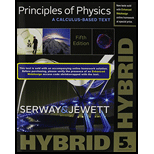
Concept explainers
(a)
The energy released in the reaction.
(a)
Answer to Problem 11P
The energy released in the reaction is
Explanation of Solution
Write the expression for the energy released in the reaction.
Here,
Conclusion:
Mass of electron is negligible.
Substitute,
Thus, the energy released in the reaction is
(b)
The speed of electron and proton after reaction.
(b)
Answer to Problem 11P
The speed of electron and proton after reaction is
Explanation of Solution
Write the expression for the conservation momentum.
Here,
Write the expression for the conservation energy by using (II).
Write the expression for the gamma factor.
Here,
Write the expression for the velocity of electron by using conservation of momentum and equation (IV).
Here,
Write the expression for the velocity of proton by using conservation of momentum and equation (II) and (IV).
Here,
Conclusion:
Substitute,
Substitute,
Substitute,
Thus, the speed of electron and proton after reaction is
(c)
The particles which is in relativistic speed.
(c)
Answer to Problem 11P
The speed of the electron is relativistic.
Explanation of Solution
The speed of electron is
The speed of light is
Want to see more full solutions like this?
Chapter 31 Solutions
Principles of Physics: A Calculus-Based Text, Hybrid (with Enhanced WebAssign Printed Access Card)
- If the rest energies of a proton and a neutron (the two constituents of nuclei) are 938.3 and 939.6 MeV, what is the difference in their mass in kilograms?arrow_forwardEnergy reaches the upper atmosphere of the Earth from the Sun at the rate of 1.79 1017 W. If all of this energy were absorbed by the Earth and not re-emitted, how much would the mass of the Earth increase in 1.00 yr?arrow_forwardThe primary decay mode for the negative pion is +v . (a) What is the energy release in MeV in this decay? (b) Using conservation of momentum, how much energy does each of the decay products receive, given the is at rest when it decays? You may assume the muon antineutrino is massless and has momentum p = E/c , just like a photon.arrow_forward
- The K0 meson is an uncharged member of the particle “zoo” that decays into two charged pions according to K0 → π+ + π−. The pions have opposite charges, as indicated, and the same mass, mπ = 140 MeV/c2. Suppose that a K0 at rest decays into two pions in a bubble chamber in which a magnetic field of 2.0 T is present (see Fig. P2.22). If the radius of curvature of the pions is 34.4 cm, find (a) the momenta and speeds of the pions and (b) the mass of the K0 meson.arrow_forwardCalculate the energy released in the + decay of 22Na, the equation for which is given in the text. The masses at 22Na and 22Ne are 21.994434 and 21.991333 u, reSpec?vely.arrow_forward(a) Write the complete + decay equation for llC. (b) Calculate the energy released in the decay. The masses of 11C and 11B are 11.011433 and 11.009305 u, respectively.arrow_forward
 Modern PhysicsPhysicsISBN:9781111794378Author:Raymond A. Serway, Clement J. Moses, Curt A. MoyerPublisher:Cengage Learning
Modern PhysicsPhysicsISBN:9781111794378Author:Raymond A. Serway, Clement J. Moses, Curt A. MoyerPublisher:Cengage Learning Principles of Physics: A Calculus-Based TextPhysicsISBN:9781133104261Author:Raymond A. Serway, John W. JewettPublisher:Cengage Learning
Principles of Physics: A Calculus-Based TextPhysicsISBN:9781133104261Author:Raymond A. Serway, John W. JewettPublisher:Cengage Learning University Physics Volume 3PhysicsISBN:9781938168185Author:William Moebs, Jeff SannyPublisher:OpenStax
University Physics Volume 3PhysicsISBN:9781938168185Author:William Moebs, Jeff SannyPublisher:OpenStax College PhysicsPhysicsISBN:9781305952300Author:Raymond A. Serway, Chris VuillePublisher:Cengage Learning
College PhysicsPhysicsISBN:9781305952300Author:Raymond A. Serway, Chris VuillePublisher:Cengage Learning Physics for Scientists and Engineers with Modern ...PhysicsISBN:9781337553292Author:Raymond A. Serway, John W. JewettPublisher:Cengage Learning
Physics for Scientists and Engineers with Modern ...PhysicsISBN:9781337553292Author:Raymond A. Serway, John W. JewettPublisher:Cengage Learning Physics for Scientists and Engineers, Technology ...PhysicsISBN:9781305116399Author:Raymond A. Serway, John W. JewettPublisher:Cengage Learning
Physics for Scientists and Engineers, Technology ...PhysicsISBN:9781305116399Author:Raymond A. Serway, John W. JewettPublisher:Cengage Learning





